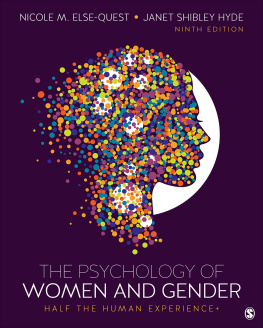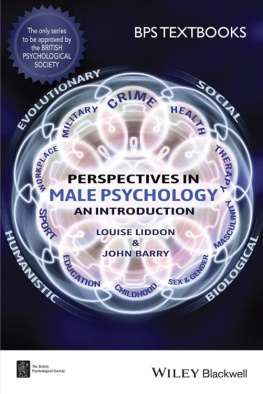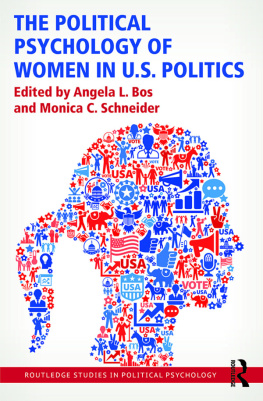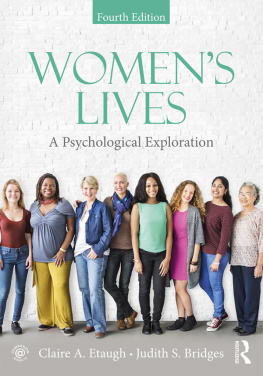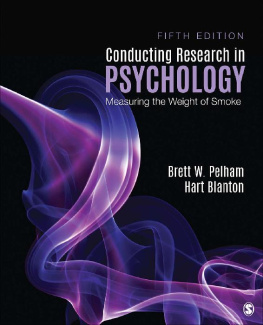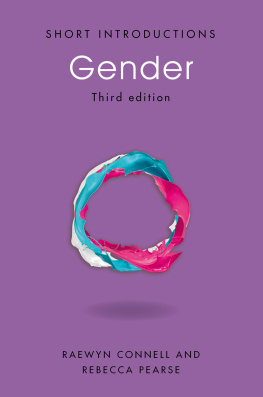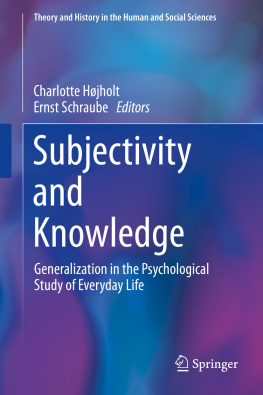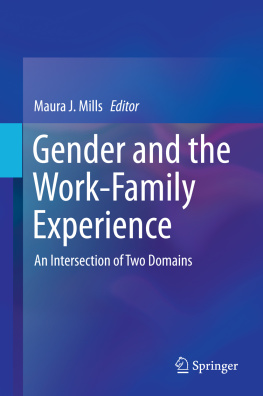The Psychology of Women and Gender
Ninth Edition
To Raeka and Isador, for the insight and perspective. (NEQ)
To Margaret and Luke, the two best kids a professor/author/mom could ever have. (JSH)
The Psychology of Women and Gender
Half the Human Experience +
Ninth Edition
- Nicole M. Else-Quest
- University of Maryland, Baltimore County
- Janet Shibley Hyde
- University of WisconsinMadison
FOR INFORMATION:
SAGE Publications, Inc.
2455 Teller Road
Thousand Oaks, California 91320
E-mail: order@sagepub.com
SAGE Publications Ltd.
1 Olivers Yard
55 City Road
London EC1Y 1SP
United Kingdom
SAGE Publications India Pvt. Ltd.
B 1/I 1 Mohan Cooperative Industrial Area
Mathura Road, New Delhi 110 044
India
SAGE Publications Asia-Pacific Pte. Ltd.
3 Church Street
#10-04 Samsung Hub
Singapore 049483
Copyright 2018 by SAGE Publications, Inc.
All rights reserved. No part of this book may be reproduced or utilized in any form or by any means, electronic or mechanical, including photocopying, recording, or by any information storage and retrieval system, without permission in writing from the publisher.
Printed in the United States of America
ISBN 978-1-5063-8282-1
This book is printed on acid-free paper.
Acquisitions Editor: Lara Parra
Editorial Assistant: Zachary Valladon
Production Editor: Laureen Gleason
Copy Editor: Sarah J. Duffy
Typesetter: C&M Digitals (P) Ltd.
Proofreader: Scott Oney
Indexer: Jeanne Busemeyer
Cover Designer: Janet Kiesel
Marketing Manager: Katherine Hepburn
Preface
Our textbook Half the Human Experience: The Psychology of Women had a good run, through eight editions. But then, in the short time between finishing the 8th edition in 2012 and the present, many things changed, foremost among them the transgender activist movement, blossoming new research on transgender individuals, and fundamental challenges to the gender binary. At the same time, scholars and activists increasingly called for a more intersectional approach to the psychology of women and gender. In light of these major shifts, we decided that the field needed not a new edition, but a very new book. We sought a new publisher and were impressed with Sages resonance with our ideas. We set out to write a new, cutting-edge textbook that thoroughly integrated intersectionality and transgender research. We developed a new title that pays homage to the textbook from which it was derived and simultaneously recognizes the new thinking about gender: The Psychology of Women and Gender: Half the Human Experience +.
Within the field of gender and womens studies today, we face a tension between the traditional emphasis on cisgender women and the new emphasis on transgender people. Transgender activists and the new research on trans people make us rethink what we mean by the term gender. We have tried hard to include that new thinking in this textbook. Yet women remain oppressed in our society and most societies in the world, and womens issues continue to deserve a focus in our courses and textbooks. Therefore, we have tried to strike a balance between an emphasis on women and an emphasis on trans folks and the new thinking about gender. Strikingly, there are many commonalities among women and trans people, the persistent challenges they face, and the profound resilience they display.
Language is extremely important. Our goal was to create a trans-inclusive textbook written in trans-inclusive language. Yet that turns out to be more difficult than it might sound. Within the trans community, there are often disagreements about preferred terminology, and terminology often changes over time. We have done our best to use respectful language based on 2017 norms, but it is possible, indeed likely, that preferred terms will change over the years. All of us need to keep up with these trends. A good basic rule is that people should be called what they prefer to be called.
Intersectionality has become a more and more prominent force in gender and womens studies, and it is increasingly making its way into psychology. We began to introduce intersectionality into the textbook in its previous incarnation. This time we integrated it thoroughly, examining its place in each chapter. This time, we had much more to work with, because intersectionality research is blossoming in psychology.
Overall, our goal has been to create a text on the psychology of women and gender written in such a way that it will be accessible to undergraduates who may have little background in psychologyperhaps only an introductory courseyet also challenging and thought-provoking for senior psychology majors or gender and womens studies majors. We want students to feel excited to learn about the psychology of women and gender, and we hope that our excitement about the field shows through for them in the book. This is truly one of the most meaningful courses that a student can take. It can be life changing. Those of us who teach it can feel a deep pride in the body of research from which we can draw.
Three characteristics of this bookits readability, comprehensiveness, and scholarshiphave been well received in previous versions, and we have worked to retain and improve those features. We believe that the readability of textbooks is a feminist principle. One of the goals of feminists has been to demystify science, and as part of that effort we must demystify psychology, including the psychology of women and gender. Our goal therefore has been to provide a text with solid, cutting-edge scholarship, clearly explained so that students can grasp itindeed, be captivated by it.
Each of us has taught psychology of women and gender numerous times using earlier versions of this textbook. We have used those experiences to polish and improve the book. For example, if students have problems with a question on an exam, is it because that passage in the book is not clearly written? If so, we fix it. Both of us have a deep understanding of what is fascinating and what is difficult for students, and we put that knowledge into our crafting of the book.
Whats new in this edition? We have kept the chapter numbering the same, although the titles of many chapters changed with the new emphasis on both transgender and intersectionality. The following are some of the highlights, although we cant begin to list all of the additions and updates.
Chapter 1: Introduction
- Updated and expanded material on important language and terminology regarding gender
- New sections on the intersectionality of gender and critiquing the gender binary
- New material on transnational feminism and gender equality around the world, mixed methods, and critical theory
Chapter 2: Theoretical Perspectives on Gender
- Added material on queer theory and intersectionality
- New Focus box: Feminist Theory in Psychology: Objectification Theory
- Expanded material on the cognitive-developmental theory of gender and the feminist critique and reformulation of evolutionary psychology

